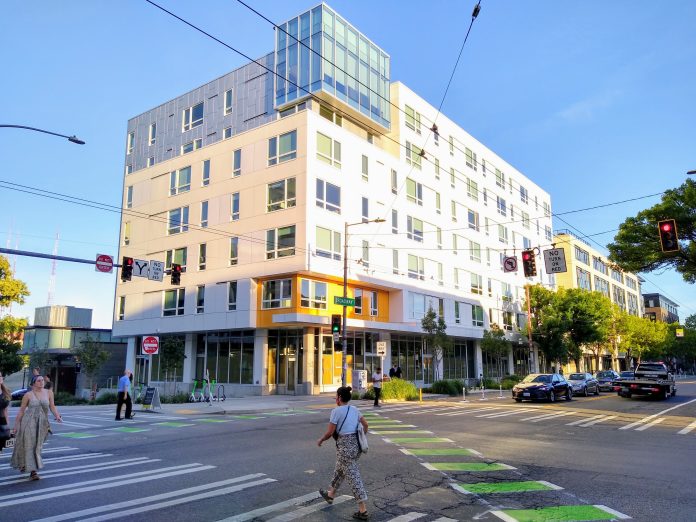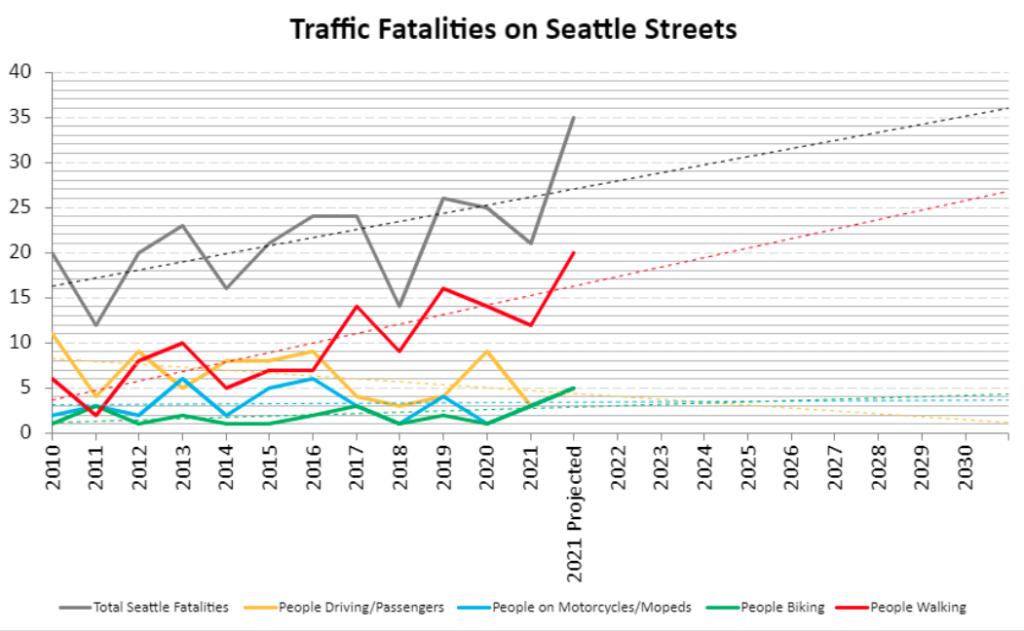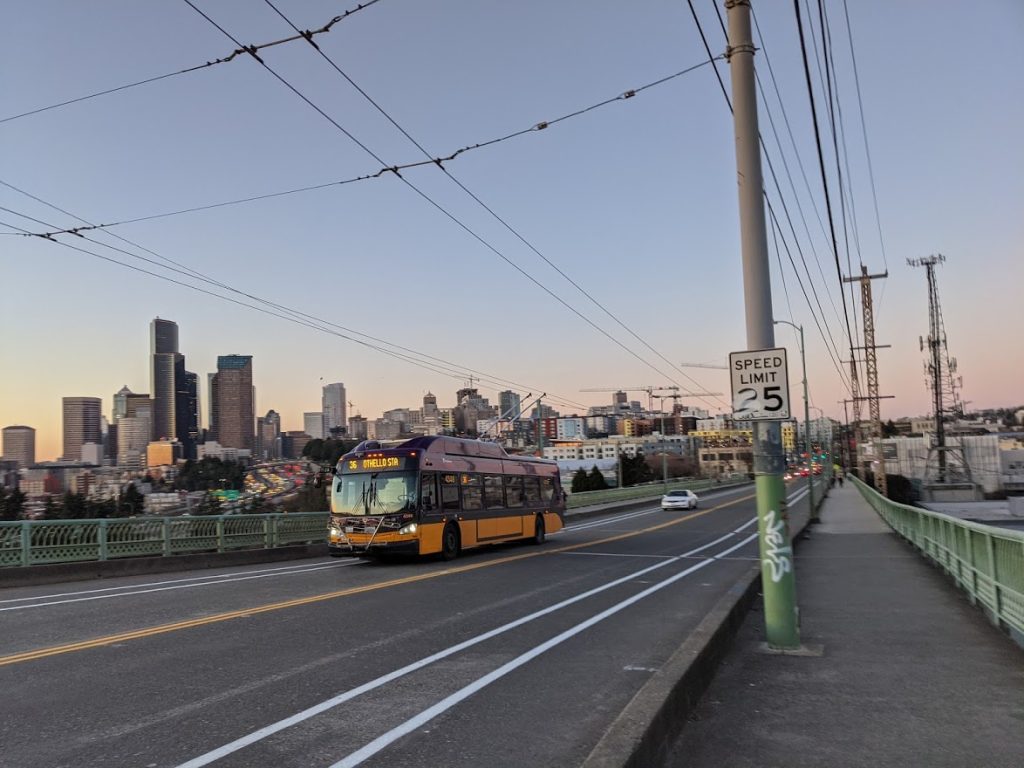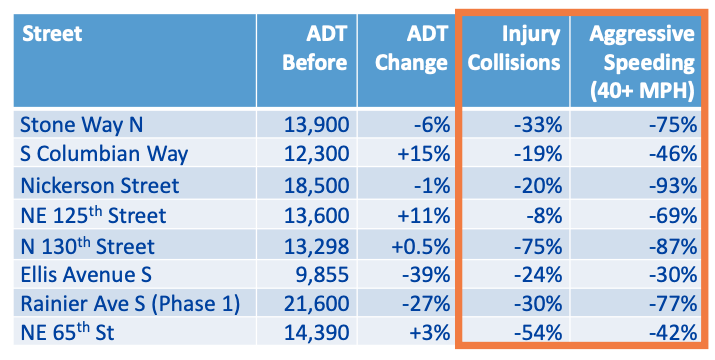
Seattle is on track to see a huge increase in the number of people killed by traffic violence on its streets in 2021. The Seattle Department of Transportation (SDOT) Vision Zero team broke the news to the Levy to Move Seattle Oversight Committee Tuesday evening. So far this year, 21 people have died in crashes due to the shortcomings of our transportation system. Based on the trends identified in the presentation, Seattle could see 35 people lose their lives by December 31st.
A number as high as 35 total fatalities for the year hasn’t been seen in the city since 2006. But in contrast with that year, data from 2021 points to a clear upward trend line for people walking and biking, indicating the city is headed in the wrong direction despite having committed in 2015 to eliminate fatalities and serious injuries on our streets by 2030.

The increase in recent years is largely the result of a rise in pedestrian-involved collisions, a nationwide trend. So far in 2021, 12 out of the 21 fatalities in the City of Seattle have been pedestrians. That number is higher than it generally is in entire years, with four months still remaining in 2021. Seattle tallied 24 traffic deaths in 2020 — 14 of them people walking, rolling, or biking. One big factor driving the jump in pedestrian fatalities is America’s trend toward larger, heavier vehicles with poor sightlines and a tendency to pull pedestrians underneath the car rather than rolling them off to the side like low-front-end vehicles tend to do.
Many of Seattle’s fatal collisions involving pedestrians have not received breaking news coverage, in part because several of them, including an August 10th crash at California Avenue SW and SW Erskine Way and a July 28 crash at 5th Avenue and Lenora Street, resulted in “merely” a serious injury at the scene. However, in both cases the person impacted later succumbed to their injuries. Serious injuries don’t make the newspaper, but deaths do.
Three people riding bikes have been hit and killed so far in 2021 as well; to put that number in context, Seattle generally sees one cyclist fatality per year. If these trends continue, the city could see five people on bikes lose their lives on our streets even as the City continues to expand the protected bike network — albeit not as fast as it should.
Seattle’s nine-year Move Seattle transportation levy funds a wide array of projects intended to improve safety, but the most targeted of these projects are the Vision Zero corridors, which promised voters 12-15 corridor safety projects. However, the deliverable for these projects was assessed as any improvement completed on those streets, not measurably improving outcomes, in this case eliminating fatalities and serious injuries. Vision Zero corridors can also vary widely from one to the next. Some projects, like the 12th Avenue S Vision Zero project, funded protected bike lanes on key segments of the city’s planned bike network. But that project held back from extending those protected bike lanes to connect with other protected facilities on Yesler Way due to traffic impact considerations, not due to any safety impact study.

Citywide, 50% of Seattle’s fatal and serious collisions occur on just 11% of the city’s street network, so targeted corridor improvements are a crucial way to make huge safety gains. But Seattle has been reluctant to tackle the challenges of its highest crash corridors, the state-run highways that bisect the city.
In the six years since launching Vision Zero, an astonishing 13.5% of all traffic fatalities in the entire city have been on Aurora Avenue N, also known as State Highway 99. While Seattle has lowered arterial speeds on non-state-highways to 25 mph, and is moving forward with speed limit adjustments on state highways in conjunction with the Washington State Department of Transportation (WSDOT), speed limit adjustments on Seattle’s fastest and busiest roads will have limited effect. A speed study that the city conducted in late May showed that at Aurora Avenue and Bridge Way, just north of the Aurora Bridge, where the speed limit is 40 mph, 89.2% of southbound drivers and 93.6% of northbound drivers were going over the speed limit, with well over a third of northbound drivers going 50 mph or over. SDOT will be receiving a $1.5 million grant this year to design changes to Aurora Avenue but it’s likely that fingerpointing between the City and the State over who is responsible for fixing Aurora Avenue will continue.
This is not to say speed limit reductions aren’t having an effect. SDOT’s initial data on reduced speed limit signs, placed in more frequent number along arterial streets, showed a 22% reduction in crashes. While that data came from a limited sample of North Seattle arterials and was obtained prior to the pandemic, it is promising. But we know physical changes to streets can have a much more significant impact, as has been seen by the number of road rechannelizations that the city has conducted, which have reduced injury collisions and curtailed aggressive speeding.

This fall, SDOT will be launching a new media campaign, “Safe and Slow Seattle”, the product of a $250,000 grant from the Washington Traffic Safety Commission. The goal of the campaign is to “increase public awareness, using positive community norms, of the benefits to lower speed limits and state laws requiring motorists to stop for pedestrians crossing at all intersections.” The speed limit messaging will be targeted citywide, while the crosswalk awareness campaign will be targeted around Seattle Public Schools that have a higher-than-average rate of free-or-reduced lunch, non-white students, and new English language learners. This media campaign comes as the SDOT Vision Zero team continues its transition away from emphasizing education as a key facet of improving traffic safety. The agency has also called on the Seattle Police Department to lessen traffic enforcement in these corridors, preferring instead to invest in engineering and design solutions it hopes will result in better safety outcomes.
What is worse than hearing that 21 people have lost their lives on our streets so far this year is feeling powerless to prevent a dire prediction about how the rest of the year will go from coming true. However, if Seattle only acted quickly on the information already in hand, lives could be saved and serious injuries prevented. Until that happens, we aren’t actually taking our commitment to Vision Zero seriously.
Ryan Packer has been writing for The Urbanist since 2015, and currently reports full-time as Contributing Editor. Their beats are transportation, land use, public space, traffic safety, and obscure community meetings. Packer has also reported for other regional outlets including BikePortland, Seattle Met, and PubliCola. They live in the Capitol Hill neighborhood of Seattle.

